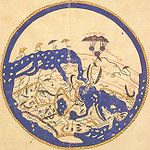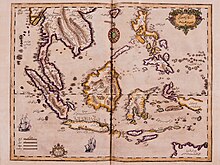Geography and cartography in the medieval Islamic world
This article has been shortened from a longer article which misused sources. |


I have seen the Rus as they came on their merchant journeys and encamped by the Itil. I have never seen more perfect physical specimens, tall as date palms, blond and ruddy; they wear neither tunics nor kaftans, but the men wear a garment which covers one side of the body and leaves a hand free. Each man has an axe, a sword, and a knife, and keeps each by him at all times. Each woman wears on either breast a box of iron, silver, copper, or gold; the value of the box indicates the wealth of the husband. Each box has a ring from which depends a knife. The women wear neck-rings of gold and silver. Their most prized ornaments are green glass beads. They string them as necklaces for their women.
Ibn Fadlan, on the Rus merchants at Itil, 922.
Geography and cartography in Islam refers to the advancement of geography, cartography and the earth sciences in the Islamic civilization.
After its beginnings in the 8th century based on Hellenistic geography,[1] Islamic geography was patronized by the Abbasid caliphs of Baghdad. Various Islamic scholars contributed to its development, and the most notable include Al-Khwārizmī, Abū Zayd al-Balkhī (founder of the 'Balkhī school') and Abu Rayhan Biruni. Muslim geography reached its apex with Muhammad al-Idrisi in the 12th century. Later developments took place under Turks, particularly under the Ottoman Empire, with notable scholars such as Mahmud al-Kashgari and Piri Reis.
Impetus
Previous learning
Islamic cartographers inherited Ptolemy's Almagest and Geographia in the 9th century which is said to have stimulated an interest in geography and map-making, however, they made almost no direct use of the latter in map-making.[2] The way in which earlier knowledge reached Muslim scholars is crucial. For example, since Muslims inherited Greek writings directly without the influence of the Latin west, T-O maps play no role in Islamic cartography though popular in the European counterpart.[2] Muslim scientists then made many of their own contributions to geography and the earth sciences.
See also
Notes and references
- Notes
- Citations
- ^ Gerald R. Tibbetts, The Beginnings of a Cartographic Tradition, in: John Brian Harley, David Woodward: Cartography in the Traditional Islamic and South Asian Societies, Chicago, 1992, pp. 90-107 (97-100), ISBN 0-226-31635-1
- ^ a b Edson & Savage-Smith 2004, pp. 61–63.
- Bibliography
- Alavi, S. M. Ziauddin (1965), Arab geography in the ninth and tenth centuries, Aligarh: Aligarh University Press
- Edson, Evelyn; Savage-Smith, Emilie (2004). Savage-Smith, Emilie (ed.). Views of the Cosmos. Oxford: Bodleian Library. ISBN 978-1-85124-184-2.
{{cite book}}: Invalid|ref=harv(help) - King, David A. (1983), "The Astronomy of the Mamluks", Isis, 74 (4): 531–555, doi:10.1086/353360
- King, David A. (2002), "A Vetustissimus Arabic Text on the Quadrans Vetus", Journal for the History of Astronomy, 33: 237–255
- King, David A. (December 2003), "14th-Century England or 9th-Century Baghdad? New Insights on the Elusive Astronomical Instrument Called Navicula de Venetiis", Centaurus, 45 (1–4): 204–226, doi:10.1111/j.1600-0498.2003.450117.x
- King, David A. (2005), In Synchrony with the Heavens, Studies in Astronomical Timekeeping and Instrumentation in Islamic Civilization: Instruments of Mass Calculation, Brill Publishers, ISBN 90-04-14188-X
- McGrail, Sean (2004), Boats of the World, Oxford University Press, ISBN 0-19-927186-0
- Mott, Lawrence V. (May 1991), The Development of the Rudder, A.D. 100-1337: A Technological Tale, Thesis, Texas A&M University
- Rashed, Roshdi; Morelon, Régis (1996), Encyclopedia of the History of Arabic Science, vol. 1 & 3, Routledge, ISBN 0-415-12410-7
- Sezgin, Fuat (2000), Geschichte Des Arabischen Schrifttums X–XII: Mathematische Geographie und Kartographie im Islam und ihr Fortleben im Abendland, Historische Darstellung, Teil 1–3 (in German), Frankfurt am Main
{{citation}}: CS1 maint: location missing publisher (link)
External links
- "How Greek Science Passed to the Arabs" by De Lacy O'Leary
- Islamic Geography in the Middle Ages
